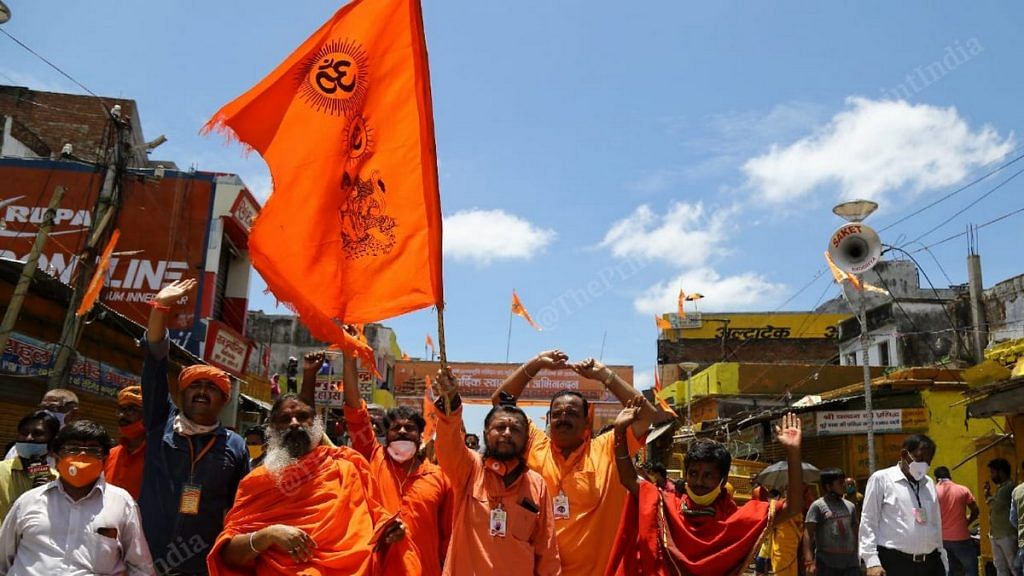Twenty-seven years and seven Lok Sabha elections later, a special Central Bureau of Investigation court has acquitted all 32 people accused of criminal conspiracy to demolish the dilapidated Babri structure in Ayodhya on 6 December 1992. The court said the accused, at least the important ones among them, didn’t conspire to demolish the structure and actually appealed repeatedly to those indulging in the demolition to withdraw. The court has also found no evidence of the involvement of the Rashtriya Swayamsevak Sangh or the Vishwa Hindu Parishad in the demolition.
After the Supreme Court judgment allowing the construction of Ram temple in Ayodhya, the case against the demolition had anyway become infructuous. Hundreds and thousands of documents running into several pages were provided to the Supreme Court before, during and after the Congress-led UPA government’s ten-year tenure. Yet, not even a shred of evidence could be produced to conclusively prove the conspiracy and complicity of the Bharatiya Janata Party (BJP) leaders and others accused in the demolition of the Babri structure in 1992.
This verdict should, in all probability, come as the epilogue of one of the longest-running court cases in India that formed and brought down many governments, decided the political destiny of many politicians and culminated in laying the foundation of a grand Ram Temple at the site where it is believed to have existed centuries ago. The Ayodhya movement was initiated by a small team of Rashtriya Swayamsevak Sangh (RSS) veterans who envisaged a grand temple as a symbol of Hindu unity, awareness and assertion.
Also read: Babri Masjid demolition verdict reflects very poorly on CBI’s ability to ensure justice
Movement’s not over yet
The special CBI court verdict, therefore, should be the last page of the book, a la obituary for the structure that an invader built over the demolished temple. Ideally, all court cases related to the Ayodhya movement should be considered closed now. But it is very unlikely that the movement that began for the Ram Temple at Ayodhya will end here.
The original movement, called the “Janmasthan Mukti Sangharsha Samiti”, envisaged the ‘liberation’ of three important temples dedicated to the three Hindu triumvirates — “Ram and Krishna and Siva” — as veteran Socialist leader Ram Manohar Lohia had explained in an essay written in 1956. It is only a matter of time before movements to ‘liberate’ the other two temples in Kashi and Mathura begin. Given the increasing assertiveness of a large section of the Hindu society and the highly emotive nature of the demands, there may not be enough scope for a negotiated settlement.
The Supreme Court has clearly given the green signal for the Ram Temple in Ayodhya and the bhoomi pujan has also been done. The Archaeological Survey of India (ASI)’s 2003 report, which the Supreme Court relied on for its verdict last November, says that a ‘Hindu structure’ was found at the disputed site.
Also read: Why Babri masjid demolition verdict is unlikely to end all temple-mosque disputes
The politics that doesn’t work
Those who berate the karsevaks for the 1992 incident should pause for a moment and think about the untold atrocities committed on them in earlier years when there were peaceful protests and limited functions legally permitted by the courts. The political opposition to Ram Mandir was evident in the narratives, especially in Uttar Pradesh and the Hindi belt. Then UP Chief Minister Mulayam Singh Yadav had famously boasted that not even a sparrow can enter the prohibited area.
The operative part of the court order allowing karseva to be performed in a limited area close to the disputed site was not revealed even as the judgment was reserved days before 6 December. The pent-up anger of a majority of Hindus represented by the karsevaks broke all limits of patience that day. What is important to note is that except the Babri structure, not a single mosque in the town was touched by the irate karsevaks. It is strange that no court or the apologists of the “Babri structure” even mention this.
The Congress party has officially called for a revision of the CBI court verdict. The party probably continues to think that it will be able to replace the Ram Temple with a masjid someday. The Congress is either utterly naïve or supremely unintelligent to think that the temple issue can be spun into a political issue to the benefit of the party’s revival plans. There is a sea change in the attitude of the Muslim community, which like any other community wants its share of peace and progress. Above all, any polarisation on the mandir-versus-masjid issue and taking a stridently anti-Hindu stand may not necessarily benefit the BJP but it will certainly harm the Congress. The party that did practically nothing in 1992 to save the situation or in 2009 after the Liberhan Commission report has no credibility left.
Seshadri Chari is the former editor of ‘Organiser’. Views are personal.
